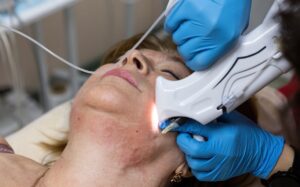6 Whitening Facial Misconceptions in Singapore Debunked

For years, the pursuit of glowing skin has directed many along a route filled with prevalent misconceptions and misunderstandings, particularly regarding brightening facial therapies. It’s time to clarify what truly works and dispel some ongoing misconceptions. These aren’t just minor missteps; they’re deeply ingrained beliefs that can actively hinder your progress towards a luminous and healthy complexion. It’s time to move beyond these outdated notions and embrace a more informed approach to skincare, particularly when it comes to achieving that coveted radiant glow.
Let’s uncover the unexpected truths and myths about whitening facial treatments that could change your skincare regimen.
1. “Immediate, Drastic Whitening Is the Goal”
A successful facial is widely thought to provide an immediately significantly lighter skin tone. The truth is considerably more complex and beneficial for your skin. Genuine skin brightening aims to create a uniform skin tone, diminish hyperpigmentation, and boost your natural glow. Consider it more as “clarifying” rather than “whitening.” Treatment methods that promise quick results often utilise harsh components that can harm the skin barrier, resulting in sensitivity, redness, and potentially a resurgence in pigmentation. A steady, methodical strategy is essential for enduring skin wellness and a genuine radiance.
2. “More Frequent Facials Mean Faster Results”
Although consistent skincare is important, excessive use of facial treatments can be detrimental. Your skin requires time to heal and react to the treatments. Excessive facials, particularly those that include exfoliation or strong active ingredients, can remove the skin’s natural oils, weaken its protective barrier, and cause irritation. A suggested timetable, typically every 3-4 weeks, corresponds with your skin’s normal cell renewal process, enabling the best outcomes without excessive pressure on your skin. Paying attention to your skin and talking to a skincare expert can assist in identifying the optimal frequency for your individual requirements.
3. “All Whitening Ingredients Are the Same”
The phrase “whitening” may be deceptive, since not every ingredient promoted for brightening operates through the same mechanism or has equivalent effectiveness. Certain ingredients, such as hydroquinone, are strong but may cause side effects and are frequently regulated, whereas others, like Vitamin C, niacinamide, and alpha arbutin, function by blocking melanin production or decreasing its movement to the surface of the skin, fostering a more uniform complexion. Grasping the active components in your whitening facial products is essential. Natural extracts such as liquorice root and mulberry provide notable brightening advantages gently. Always choose therapies that emphasise skin health and incorporate thoroughly studied, safe components.
4. “Sun Protection Is Only for Preventing New Spots”
It’s a widespread belief that sun protection merely prevents new dark spots from forming after a brightening facial. The truth is, UV exposure can also reactivate existing melanin, even in areas where pigmentation has been successfully reduced. Sun protection is not just preventative; it’s essential for maintaining the results of any brightening facial and ensuring your efforts aren’t undone. Daily use of a broad-spectrum SPF, even on cloudy days or indoors near windows, is non-negotiable for preserving your skin’s clarity and preventing the recurrence of discolouration. Sunscreen forms a critical part of the post-facial care routine, safeguarding your newly brightened complexion.
5. “At-Home Products Can’t Rival Professional Treatments”
While professional facial treatments offer concentrated formulas and expert application, dismissing the power of a consistent at-home skincare routine is a mistake. Many effective whitening facial products are available for home use that can significantly enhance and prolong the results of professional treatments. Serums, essences, and masks containing ingredients like Vitamin C, retinol (if suitable for your skin), and various botanical extracts can work synergistically with in-clinic procedures. The key lies in selecting high-quality products tailored to your skin concerns and consistently incorporating them into your daily regimen. Think of your at-home routine as the daily maintenance that keeps your skin glowing between professional visits.
6. “Brightening Facials Are Only for Pigmentation Issues”
While often sought out for reducing dark spots and uneven tone, a facial offers a multitude of benefits beyond just addressing pigmentation. These treatments typically incorporate deep cleansing, exfoliation, and hydration, which collectively improve overall skin health, texture, and radiance. They can help diminish dullness, reduce the appearance of fine lines by promoting cell turnover, and give your skin a smoother, more refined look. Essentially, a facial is a comprehensive treatment that revitalises the skin, making it suitable for anyone looking to enhance their complexion, not just those with specific pigmentation concerns.
The journey to radiant skin is often filled with misconceptions, particularly regarding brightening facial treatments. By understanding that true brightening involves a consistent, gentle approach, prioritising skin health over drastic changes, and recognising the importance of ongoing sun protection and a robust home care routine, you can achieve a truly luminous complexion. It’s about embracing a holistic view of skincare, where patience and informed choices lead to lasting results. Remember, a healthy glow is a reflection of well-cared-for skin.
Contact Fresver Beauty to learn more about achieving your skin goals.





